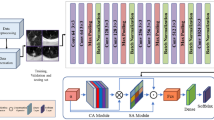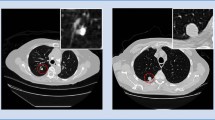Abstract
Malignant lung nodules are the worse stage for lung cancer patients. Early detection of lung nodules is essential for early treatment of the patients and significantly improves their survival rate. Recently, several computer-aided diagnosis (CAD) schemes based on deep learning approaches have been suggested to assist in lung nodule diagnosis. This study presents a 3D U-shaped encoding and decoding deep convolutional neural network (CNN) integrated with channel attention mechanisms for lung nodule detection in chest CT images. The U-shaped network applies the encoder to extract nodule representation features and the decoder to indicate the prediction results of the nodule candidates. Hybrid efficient channel attention (ECA) modules are integrated to enhance network representation power by retaining rich contextual nodule information and suppressing useless features. Correspondingly, the 3D regional proposal network (RPN) with three anchor boxes is employed for multilevel nodule candidates detection. The Lung Nodule Analysis 2016 (LUNA16) dataset was used to validate the proposed method. Experimental results show that through 10-fold cross-validation, the proposed algorithm gives the highest detection sensitivity of 98.65% and the competition performance metric (CPM) value of 0.911. Therefore, the results of our design show competitiveness compared with the methods in the prior studies for lung nodule detection in chest CT images.






Similar content being viewed by others
Data availability
The research work uses the LUNA16 dataset that is available online through https://luna16.grand-challenge.org/
Code availability
Custom codes.
References
Afshar P, Naderkhani F, Oikonomou A, Rafiee MJ, Mohammadi A, Plataniotis KN (2021) MIXCAPS: a capsule network-based mixture of experts for lung nodule malignancy prediction. Pattern Recogn 116:107942. https://doi.org/10.1016/j.patcog.2021.107942
Cao H et al (2019) Multi-branch ensemble learning architecture based on 3D CNN for false positive reduction in lung nodule detection. IEEE Access 7:67380–67391. https://doi.org/10.1109/ACCESS.2019.2906116
Chen L et al (2021) An artificial-intelligence lung imaging analysis system (ALIAS) for population-based nodule computing in CT scans. Comput Med Imaging Graph 89:101899. https://doi.org/10.1016/j.compmedimag.2021.101899
De Moura J et al (2018) Multi-view multi-scale CNNs for lung nodule type classification from CT images. IEEE Trans Med Imaging 7(1):1–12. https://doi.org/10.1117/12.2285954
Dutande P, Baid U, Talbar S (2021) LNCDS: a 2D-3D cascaded CNN approach for lung nodule classification, detection and segmentation. Biomed Signal Process Control 67:102527. https://doi.org/10.1016/j.bspc.2021.102527
Fu J et al (2019) Dual attention network for scene segmentation. Proc IEEE Comput Soc Conf Comput Vis Pattern Recognit 2019:3141–3149. https://doi.org/10.1109/CVPR.2019.00326
Furst JD, Raicu DS, Mahesh S, Jenuwine N (2018) Lung nodule detection from CT scans using 3D convolutional neural networks without candidate selection. Med. Imaging Comput. Diagnosis 1057539:116. https://doi.org/10.1117/12.2293918
Gong L, Jiang S, Yang Z, Zhang G, Wang L (2019) Automated pulmonary nodule detection in CT images using 3D deep squeeze-and-excitation networks. Int J Comput Assist Radiol Surg 14(11):1969–1979. https://doi.org/10.1007/s11548-019-01979-1
Gu Y et al (2019) Automatic lung nodule detection using multi-scale dot nodule-enhancement filter and weighted support vector machines in chest computed tomography. PLoS One 14(1):e0210551. https://doi.org/10.1371/journal.pone.0210551
Gu D, Liu G, Xue Z (2021) On the performance of lung nodule detection, segmentation and classification. Comput Med Imaging Graph 89:101886. https://doi.org/10.1016/j.compmedimag.2021.101886
Halder A, Dey D, Sadhu AK (2020) Lung nodule detection from feature engineering to deep learning in thoracic CT images: a Comprehensive Review. J Digit Imaging 33(3):655–677. https://doi.org/10.1007/s10278-020-00320-6
Heuvelmans MA et al (2021) Lung cancer prediction by Deep Learning to identify benign lung nodules. Lung Cancer 154:1–4. https://doi.org/10.1016/j.lungcan.2021.01.027
Hu J (2018) Squeeze-and-Excitation_Networks_CVPR_2018_paper.pdf, Cvpr, pp. 7132–7141, 2018, [Online]. Available: http://openaccess.thecvf.com/content_cvpr_2018/html/Hu_Squeeze-and-Excitation_Networks_CVPR_2018_paper.html.
Huang X, Shan J, Vaidya V (2017) Lung nodule detection in CT using 3D convolutional neural networks. Proc - Int Symp Biomed Imaging:379–383. https://doi.org/10.1109/ISBI.2017.7950542
Janocha K, Czarnecki WM (2016) On loss functions for deep neural networks in classification. Schedae Informaticae 25:49–59. https://doi.org/10.4467/20838476SI.16.004.6185
Jiang H, Ma H, Qian W, Gao M, Li Y (2018) An automatic detection system of lung nodule based on multigroup patch-based deep learning network. IEEE J Biomed Heal Informatics 22(4):1227–1237. https://doi.org/10.1109/JBHI.2017.2725903
Li Y, Y Fan (2020) DeepSEED: 3D squeeze-and-excitation encoder-decoder convolutional neural networks for pulmonary nodule detection. IEEE 17th Int. Symp Biomed Imaging, pp. 1866–1869
Li X, Wang W, Hu X, Yang J (2019) Selective kernel networks. Proc IEEE Comput Soc Conf Comput Vis Pattern Recognit 2019:510–519. https://doi.org/10.1109/CVPR.2019.00060
LIDC-IDRI - The Cancer Imaging Archive (TCIA) Public Access (2021). https://wiki.cancerimagingarchive.net/display/Public/LIDC-IDRI.
Liu J, Gong J, Wang L, Sun X, Nie S (2019) Segmentation refinement of small-size juxta-pleural lung nodules in CT scans. Iran J Radiol 16(1). https://doi.org/10.5812/iranjradiol.65034
Lung Nodule Analysis 2016 (2021). https://luna16.grand-challenge.org/
Lv W et al (2021) Development and validation of a clinically applicable deep learning strategy (HONORS) for pulmonary nodule classification at CT: a retrospective multicentre study. Lung Cancer 155:78–86. https://doi.org/10.1016/j.lungcan.2021.03.008
Mittapalli PS, Thanikaiselvan V (2021) Multiscale CNN with compound fusions for false positive reduction in lung nodule detection. Artif Intell Med 113(2019):102017. https://doi.org/10.1016/j.artmed.2021.102017
Qin R et al (2020) Fine-grained lung cancer classification from PET and CT images based on multidimensional attention mechanism. Complexity 2020. https://doi.org/10.1155/2020/6153657
S. Ren, K. He, R. Girshick, and J. Sun, "Faster R-CNN: towards real-time object detection with region proposal networks," IEEE Trans Pattern Anal Mach Intell, vol. 39, no. 6, pp. 1137–1149, Jun. 2017, https://doi.org/10.1109/TPAMI.2016.2577031.
Schultheiss M et al (2020) OPEN a robust convolutional neural network for lung nodule detection in the presence of foreign bodies. Sci Rep:1–9. https://doi.org/10.1038/s41598-020-69789-z
Setio AAA et al (2016) Pulmonary nodule detection in CT images: false positive reduction using multi-view convolutional networks. IEEE Trans Med Imaging 35(5):1160–1169. https://doi.org/10.1109/TMI.2016.2536809
Sung H et al (2020) Global cancer statistics 2020: GLOBOCAN estimates of incidence and mortality worldwide for 36 cancers in 185 countries. CA. Cancer J Clin 2021. https://doi.org/10.3322/caac.21660
Valente IRS, Cortez PC, Neto EC, Soares JM, de Albuquerque VHC, Tavares JMRS (2016) Automatic 3D pulmonary nodule detection in CT images: a survey. Comput Methods Prog Biomed 124:91–107. https://doi.org/10.1016/j.cmpb.2015.10.006
Wang Q, Shen F, Shen L, Huang J, Sheng W (2019) Lung nodule detection in CT images using a raw patch-based convolutional neural network. J Digit Imaging. https://doi.org/10.1007/s10278-019-00221-3
Wang J et al (2019) Pulmonary nodule detection in volumetric chest CT scans using CNNs-based nodule-size-adaptive detection and classification. IEEE Access 7:46033–46044. https://doi.org/10.1109/ACCESS.2019.2908195
Wang Q, Wu B, Zhu P, Li P, Zuo W, Hu Q (2020) ECA-net: efficient channel attention for deep convolutional neural networks. Proc IEEE Comput Soc Conf Comput Vis Pattern Recognit:11531–11539. https://doi.org/10.1109/CVPR42600.2020.01155
Xie H, Yang D, Sun N, Chen Z, Zhang Y (2019) Automated pulmonary nodule detection in CT images using deep convolutional neural networks. Pattern Recogn 85:109–119. https://doi.org/10.1016/j.patcog.2018.07.031
Xu Q, Shan W, Zhu Y, Huang C, Bao S, Guo L (2021) Prediction efficacy of feature classification of solitary pulmonary nodules based on CT radiomics. Eur J Radiol 139(1):109667. https://doi.org/10.1016/j.ejrad.2021.109667
Yu L, Dou Q, Chen H, Heng P-A, Qin J (2016) Multilevel contextual 3-D CNNs for false positive reduction in pulmonary nodule detection. IEEE Trans Biomed Eng 64(7):1558–1567. https://doi.org/10.1109/tbme.2016.2613502
Zhang X, Zhou X, Lin M, Sun J (2018) ShuffleNet: an extremely efficient convolutional neural network for Mobile devices. Proc IEEE Comput Soc Conf Comput Vis Pattern Recognit:6848–6856. https://doi.org/10.1109/CVPR.2018.00716
Zhang M, Kong Z, Zhu W, Yan F, Xie C (2021) Pulmonary nodule detection based on 3D feature pyramid network with incorporated squeeze-and-excitation-attention mechanism. Concurr Comput 2020:1–9. https://doi.org/10.1002/cpe.6237
Zhu W, Liu C, Fan W, Xie X (2018) DeepLung: deep 3D dual path nets for automated pulmonary nodule detection and classification. Proc. - 2018 IEEE Winter Conf Appl Comput Vision, WACV 2018:673–681. https://doi.org/10.1109/WACV.2018.00079
Zuo W, Zhou F, Li Z, Wang L (2019) Multi-resolution cnn and knowledge transfer for candidate classification in lung nodule detection. IEEE Access 7:32510–32521. https://doi.org/10.1109/ACCESS.2019.2903587
Acknowledgments
We would love to thank the Editors and synonyms reviewers for their constructive comments on improving our work.
Funding
This work is supported by The National Natural Science Foundation of China under Grant numbers 61671185 and 62071153.
Author information
Authors and Affiliations
Corresponding author
Ethics declarations
Conflict of interest
The authors declare that they have no known competing financial interests or personal relationships that could have influenced the work reported in this paper.
Additional information
Publisher’s note
Springer Nature remains neutral with regard to jurisdictional claims in published maps and institutional affiliations.
Rights and permissions
Springer Nature or its licensor (e.g. a society or other partner) holds exclusive rights to this article under a publishing agreement with the author(s) or other rightsholder(s); author self-archiving of the accepted manuscript version of this article is solely governed by the terms of such publishing agreement and applicable law.
About this article
Cite this article
Mkindu, H., Wu, L. & Zhao, Y. Lung nodule detection of CT images based on combining 3D-CNN and squeeze-and-excitation networks. Multimed Tools Appl 82, 25747–25760 (2023). https://doi.org/10.1007/s11042-023-14581-0
Received:
Revised:
Accepted:
Published:
Issue Date:
DOI: https://doi.org/10.1007/s11042-023-14581-0




